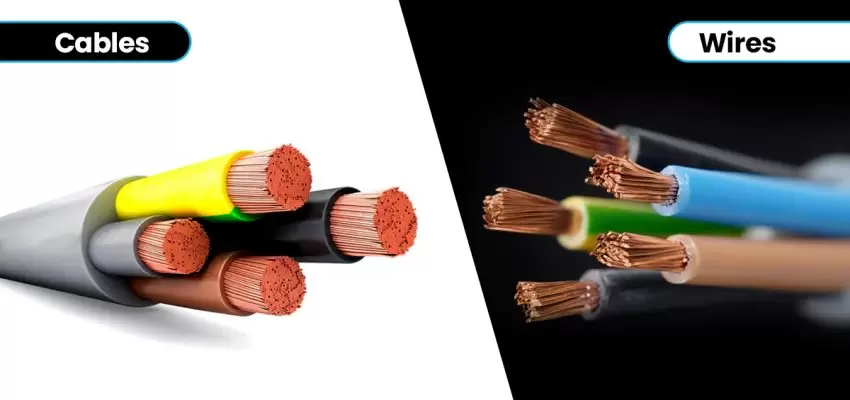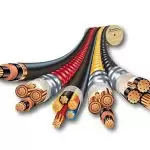Cables and wires are essential parts of many electrical networks and systems; the terms are sometimes used synonymously, which causes misunderstanding. Cables and wires are not the same thing, though. It is crucial to comprehend the differences between them to choose, install, and maintain them effectively in a variety of applications. The definitions of wires and cables will be made clearer in this article, along with a comparison of their salient traits and features and an overview of the primary determinants of their suitability for various use cases.
Post your Requirement
What Is The Difference Between Wires And Cables?
| Aspect | Wires | Cables |
|
Composition |
Wires are singular conductive strands made of metal, usually copper or aluminum. They are the fundamental building blocks of cables. |
Cables consist of multiple wires grouped and insulated as a unit. This bundling provides protection and organization to the individual conductors. |
|
Function |
Wires primarily serve as simple conductors, transmitting electrical signals or power from one point to another. | Cables, on the other hand, are designed to perform more complex functions. They can transmit data, power, or both simultaneously, depending on their construction and purpose. |
| Insulation | Wires typically have basic insulation, providing minimal protection against external factors. |
Cables feature advanced insulation, shielding the bundled wires from interference, noise, and environmental conditions. This enhanced insulation ensures reliable signal transmission. |
| Flexibility |
Wires are generally more flexible and easy to manipulate due to their single-strand nature. |
Cables can be flexible or rigid, depending on their construction. Some cables are designed for frequent movement and bending, making them suitable for applications like robotics or portable electronics. |
| Applications |
Wires find common use in simple applications, such as connecting components on a circuit board or creating basic electrical connections. |
Cables are employed in more complex scenarios, like networking (Ethernet cables), power distribution (extension cords), or transmitting audio and video signals (HDMI cables). |
| Examples |
Examples of wires include single-strand hook-up wire or speaker wire. |
Examples of cables include Ethernet cables for networking, USB cables for data transfer, and power cables for supplying electrical power. |
Electrical Wires Vs Cables: Understand The Key Differences
1. Definition
An electric wires is a single slender, flexible strand or rod of metal, usually copper or aluminum. Wires conduct electricity and serve to join electrical circuits as components or connectors. They provide point-to-point connections within a circuit.
In contrast, a cable is an assembly of one or more insulated electrical wires or optical fibers, bundled together inside a common protective jacket. Cables provide connectivity for transferring information signals and electric power. The bundled wires allow cables to carry more information and higher electric currents than a single wire.
2. Composition And Construction
Wires are singular conductive strands, whereas cables contain a core set of conductive wires, insulated and encased in an outer sheath. This key distinction impacts their capabilities and applications.
Wires do not usually have insulation or jacketing like cables do, although some wires may have basic insulation for safety and performance. More often, wire insulation is provided separately by conduits, raceways, or other confinements when installed.
Cables have additional layers and components depending on performance specifications, such as insulation over individual wires, foam or tape separators between wires, metallic shielding or braided screens, and the main external jacket holding components in place. This layered build provides cables with much greater capabilities than uninsulated wires in terms of data speeds, EMI reduction, and environmental protection.
3. Conductors
The conductor materials in wires and cables also differ. Wires for power transmission often use aluminium or copper due to their high conductivity and ductility. Telecom wires tend to use copper which has better electrical properties for signaling.
Cables may also utilize copper or aluminium conductors but additionally include options like tin-plated copper or silver-coated copper for specialized applications. The choice comes down to balancing conductivity, corrosion resistance, flexibility, weight, and cost factors for the cable’s operating conditions.
4. Usage Ratings
Wires are used for lower power applications, control circuits, instruments, and other light electrical connections, transmitting from a few volts up to 600-1000 V. Maximum safe ampacity ratings for wires would be around 50 A or less. Temperature, insulation type, and conductor size influence capacities.
Cables accommodate much higher transmission ratings, larger power loads, and data rates. Cables have increased ampacity well over 2000A, operating voltages over 230 kV, and data transfer reaching 100 Gbps on modern fibre optic and ethernet cable technology.
5. Cost Considerations
Generally, the wires prove to be cheaper than cables as they comprise a single conductor or fewer strands. The reduced material needs and simple designs reduce the overall costs, thereby proving to be a cost-effective choice for applications covering short distances in favourable conditions.
Cables, on the other hand, prove to be comparatively expensive with their multiple conductions, insulation, and shielding that increases the overall material and manufacturing costs. However, in applications that either need to cover long distances or withstand extreme conditions, the cables prove to be more cost-effective. The wires come with reduced upfront costs, but the need for replacement with failure in operations or breakdown is significantly high, thereby making it a costly option for heavy applications.
6. Types & Variations
The wires are mainly of two types: the solid wire and the stranded wire. The solid wire is a single strand of copper, while the stranded wire is a kind of wire made with several smaller copper strands braided together to form a single conductor. While the solid wire is highly effective for conducting electricity, the stranded wire is preferred for applications featuring frequent movement, thereby requiring higher resistance to breakage. The most widely used material for wires is copper, with its excellent heat resistance and electricity conductivity that comes with an affordable price range. Additionally, you should prefer to go for larger gauges of copper wires for higher power uses and smaller gauges for limited uses.
Cables also come in a variety of types, with a lot more options than wires. You can go for anything from coaxial, twisted pair, fiber optic, multi-core power cables, and numerous others, ensuring greater versatility to a diverse range of different applications. Each cable comes with a different design, tailored to a wholly different purpose and designed to withstand a different range of environmental conditions such as humidity, high temperatures, and exposure to UV radiation.
7. Applications
The design of the wires and cables vastly determine the applications of the structures and how they can perform in heavy-duty uses. The single conductor of wires is particularly designed for small-scale applications like circuit connections, electronic devices, and short-distance power transmission that feature limited use of power.
Cables, on the other hand, are designed to serve a broader range of applications that include heavy-duty work such as networking, power distribution, and audio-visual transmission. Suitable for longer distance uses, the cables come with an ability to function with more complex systems than wires. These structures are also widely used for telecommunications, industrial machinery, and underground or overhead power distribution.
8. Durability
Wires comprise a single conduction and a comparatively simpler design as compared to cables, thereby relatively more flexible and versatile. However, the greater flexibility also results in a greater chance of wear and tear or breakage, particularly in harsh conditions. All this makes the wires a relatively less durable choice for diverse applications in the long run.
On the other hand, cables come with extra layers of protection, including insulation, shielding, and the design of multiple conductors, thereby making the structures a better-performing option for diverse applications. It comes with an incredible resistance to heat, moisture damage, and concerns of physical wear and tear. Therefore, cables prove to be more reliable and robust options in the long run with their ability to withstand extreme conditions and rugged environments.
In Summary
Here we have compared wires and cables in simple points:
Wires:
- Consists of a single conductive metal strand.
- Mainly provide point-to-point connections.
- It has no insulation or jacketing when used bare.
- Carry limited low-voltage power or instrument signals.
- Used for terminals, solenoids, motors, and devices.
Cables:
- Contain groups of insulated wires bundled together.
- Transmit power and signals across distances.
- Additional shielding and jacketing provide protection.
- Carry high electric current and large data loads.
- Used for electrical infrastructure, telecom, and computing.
Conclusion
The world of electrical components is vast, encompassing various wires and cables designed for specific purposes. When it comes to house wiring, the choice of the right electrical wire is important. The best wire for house wiring is often determined by factors such as conductivity, insulation, and durability. Typically, copper wires are preferred for their excellent conductivity and resistance to corrosion. However, the price of electrical wire can vary based on factors like the type of metal used and the quality of insulation.
For specific applications, such as submersible installations, specialized submersible cables become essential. These cables are designed to withstand exposure to water, making them suitable for pumps and other submerged equipment. The pricing of submersible cables is influenced by their water-resistant properties and durability.
In the realm of data transmission, Ethernet cables, LAN cables, and coaxial cables play crucial roles. Ethernet cables are widely used for networking purposes, providing reliable data transfer within local networks. The cable wire price for Ethernet cables can vary based on factors such as length and category.
Coaxial cables, known for their ability to transmit cable television signals and internet connectivity, have their pricing considerations. Meanwhile, LAN cables, commonly used in local area networks for data transmission, offer versatility and speed.
When it comes to electrical installations, the overall electrical cable price can fluctuate based on factors like the type of cable, insulation quality, and intended use. Telephone cables, another integral part of communication systems, have their pricing dynamics influenced by factors such as length and quality.
In conclusion, the pricing of electrical wires and cables is multifaceted, dependent on factors like material, application, and quality. Whether it’s for house wiring, submersible installations, or data transmission, understanding the nuances of different types of wires and cables is crucial for making informed and cost-effective decisions in various electrical and communication scenarios.
Read Also: Electrical Wires and Cables: Types, Uses, and Tips























Post A Comment